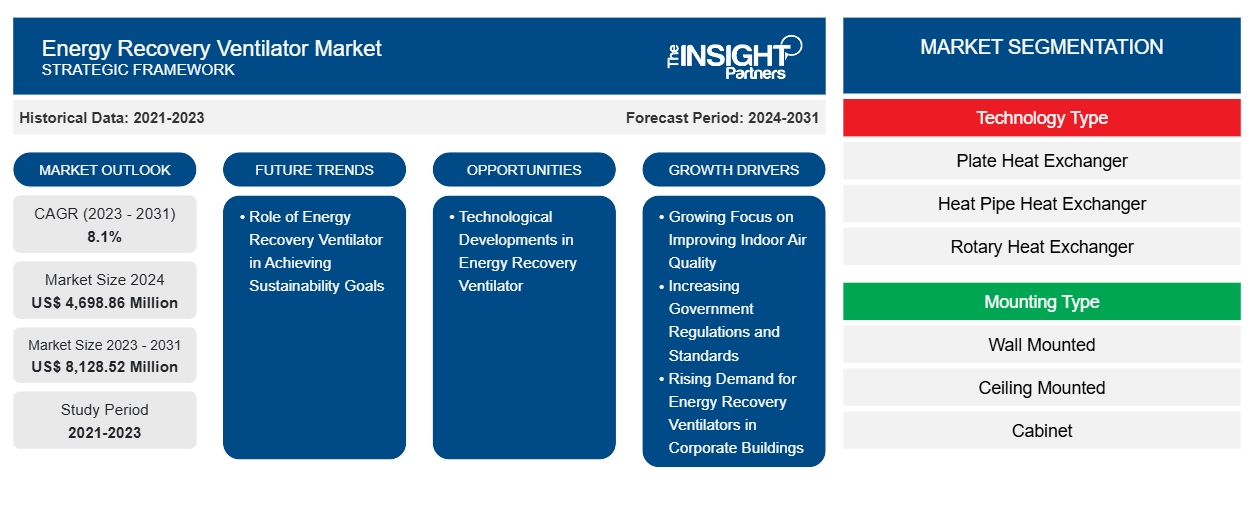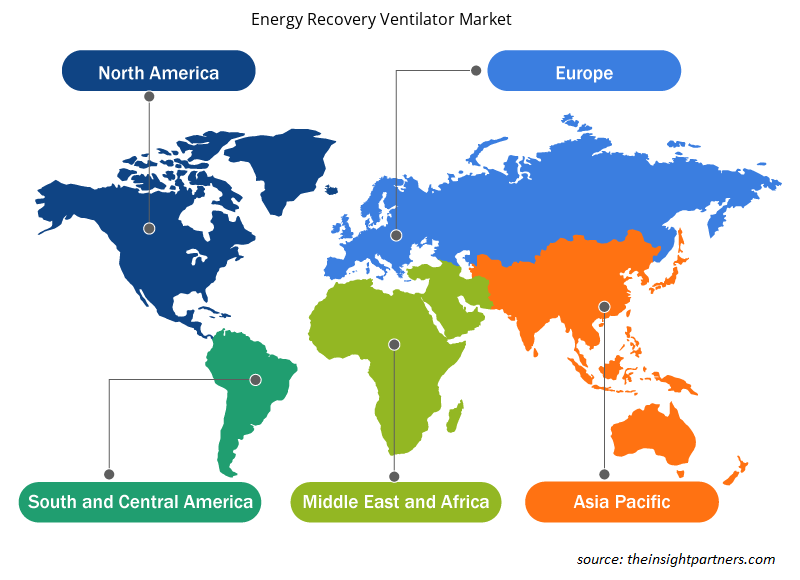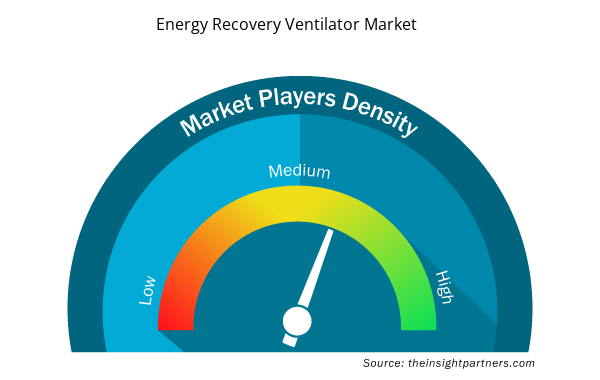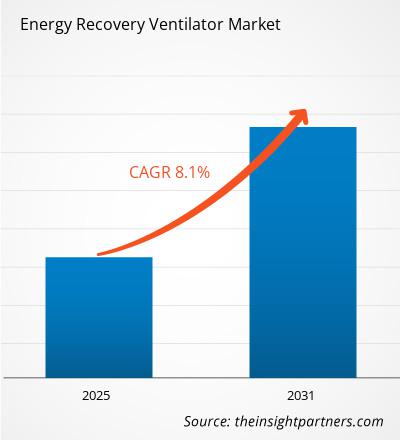预计到2031年,能量回收通风机市场规模将从2024年的46.9886亿美元增至81.2852亿美元。预计2025年至2031年期间,该市场的复合年增长率将达到8.1%。全球日益增强的可持续发展意识可能会在未来几年为市场带来新的关键趋势。
能量回收通风机市场分析
美国人大约 90% 的时间都待在室内,因此找到合适的通风策略对于营造安全健康的室内环境至关重要。随着建筑物变得更加密封、紧凑和节能,它们会滞留室内空气污染物,导致室内空气质量 ( IAQ ) 不佳。典型的污染物包括烹饪、清洁、室内装潢、家具和油漆过程中释放的挥发性有机化合物 ( VOC),以及淋浴、烹饪和呼吸产生的湿气。空气质量差或通风不良的不利影响包括健康问题、空气传播疾病的传播以及生产力低下。因此,预计在 2025 年至 2031 年期间,人们对维护住宅、商业和工业区域良好空气质量的意识的提高将推动能量回收通风机市场的发展。
在政府法规和标准的推动下,人们改善室内空气质量的意识正在不断增强。此外,企业建筑对能量回收通风机的需求也在增长,推动了市场的增长。然而,安装的复杂性和频繁的维护需求预计将阻碍能量回收通风机市场的增长。此外,预计能量回收通风机的技术发展将在未来几年为市场中的企业创造机遇。此外,预计能量回收通风机在实现可持续发展目标中的作用将成为2025-2031年能量回收通风机市场未来的关键趋势。
能量回收通风机市场概况
通风有助于减少室内空气传播疾病的传播。能量回收通风机 ( ERV ) 是一种被动式能量回收装置,用于最大限度地降低供暖、通风和空调系统的能耗。它通过从建筑物的废气中转移能量来预处理通风空气。因此,通风气流和废气气流在ERV中直接或间接地相互作用,实现能量转移。全球能量回收通风机市场增长的主要终端用户包括住宅和商业建筑,以及能源和公用事业、数据中心、零售、酒店和工业设施(制造业以外的领域)等行业。各行各业对高效、定制化的暖通空调 (HVAC ) 系统的需求日益增长,例如电路板制造、采矿、食品饮料、制药和洁净室系统。许多工业和生产建筑的排放水平很高。生产过程需要使用局部或整体排气系统频繁去除室内空气中的多余热量或污染物。因此,制造工厂正致力于使用能量回收风扇来满足通风和能源标准,同时改善室内空气质量并最大限度地降低暖通空调设备的总容量。此外,全球制造业增加值的复苏需要大量的资本投资。
定制此报告以满足您的要求
您可以免费定制任何报告,包括本报告的部分内容、国家级分析、Excel 数据包,以及为初创企业和大学提供优惠和折扣
能量回收呼吸机市场:

- 获取此报告的顶级关键市场趋势。此免费样品将包括数据分析,从市场趋势到估计和预测。
能量回收呼吸机市场驱动因素和机遇
日益重视改善室内空气质量
无论是居家还是工作场所,室内空气质量都对人们的舒适度和健康产生巨大影响。通风不足会使房间闷热难耐。接触氡、霉菌、压制木制品(可能含有甲醛)、二手烟和其他室内污染物,可能导致肺癌和哮喘等健康问题。不良的室内空气质量 (IAQ) 会对室内人员的认知功能、健康和幸福感产生负面影响。美国环境保护署 (EPA) 指出,当空气质量被评为良好时,工作场所的员工生产力可提高 5-6%。使用能量回收通风机,平衡且增强的通风可以优化室内空气质量。
能量回收通风机的技术发展
随着能量回收新风系统在各个领域的应用日益广泛,市场参与者正高度重视新产品的开发以及现有产品线的升级,以满足客户的需求。例如,松下公司于2024年2月推出了WhisperComfort 60能量回收新风系统。这款新型能量回收新风系统已获得美国家庭通风协会(HVI)的认证,将为客户提供更优质、更节能、更经济的房屋通风方案。此外,松下公司还与北美住宅建筑商ARISTA Homes合作,为住宅提供WhisperAir RepairR局部空气净化器或Intelli-Balance能量回收新风系统。此外,LG电子(LG)于2020年7月推出了Puricare空气净化解决方案的扩展产品线。这些新解决方案为工业污染或沙尘暴、灰尘等局部天气现象造成的恶劣室内空气环境提供了亟需的改善。
能量回收通风机市场报告细分分析
有助于得出能量回收通风机市场分析的关键部分是技术类型、安装类型和最终用户。
- 根据技术类型,全球能量回收通风机市场分为板式热交换器、热管热交换器、旋转式热交换器、循环盘管和其他类型。2024年,板式热交换器占据了能量回收通风机市场的主导地位。
- 根据安装类型,全球能量回收通风机市场分为壁挂式、吊顶式和柜式。2024年,壁挂式能量回收通风机占据了能量回收通风机市场的最大份额。
- 根据最终用户,能量回收通风机市场细分为住宅、商业和工业。2024年,商业领域占据市场主导地位。
能量回收通风机市场份额分析
能量回收通风机市场报告提供了详细的全球地理范围分析。北美、欧洲和亚太地区是能量回收通风机市场显著增长的主要地区。
2024 年,北美占据了能量回收通风机市场的主导地位。欧洲是全球能量回收通风机市场的第二大贡献者,其次是亚太地区。由于主要参与者专注于各行各业和房地产领域能量回收通风机的进步和采用,北美市场正经历着巨大的增长。此外,包括美国、加拿大和墨西哥在内的主要制造业经济体的存在刺激了对能量回收通风机的需求。美国是继中国之后的第二大制造业强国。2023 年,它占世界制造业总产出的约 16%。此外,随着建立制造基地的投资增加,加拿大和墨西哥正在为北美能量回收通风机市场的增长做出贡献。此外,对研发、自动化和数字化的高度重视正在推动美国对通风解决方案的需求。
欧洲在能量回收通风机市场占有重要份额。该地区以其完善的制造设施而闻名,包括汽车、航空航天、机械和建筑等行业。这些行业在制造过程中严重依赖能源,因此需要通风系统来实现其运营和生产的高精度和高效率。德国是欧洲的主要市场,以其先进的工程和制造能力而闻名。此外,该地区的住宅和商业房地产行业正在快速增长。
中国在亚太地区的能量回收通风机市场占据主导地位。汽车、航空航天、国防以及住宅和商业等制造业的蓬勃发展,推动了该地区对能量回收通风机的需求。这些行业在生产过程中需要暖通空调系统和冷水机组,这会导致更高的能耗和二氧化碳排放量。中东、非洲和南美洲也促进了能量回收通风机市场的增长,这得益于这些地区工业化投资的增加、城镇化进程的加快、商业项目的投资以及制造基地的增加。
能量回收呼吸机市场区域洞察
Insight Partners 的分析师已详尽阐述了预测期内影响能量回收呼吸机市场的区域趋势和因素。本节还讨论了北美、欧洲、亚太地区、中东和非洲以及南美和中美的能量回收呼吸机市场细分和地域分布。

- 获取能量回收通风机市场的区域特定数据
能量回收通风机市场报告范围
| 报告属性 | 细节 |
|---|---|
| 2024年的市场规模 | 46.9886亿美元 |
| 2031年的市场规模 | 81.2852亿美元 |
| 全球复合年增长率(2025-2031) | 8.1% |
| 史料 | 2021-2023 |
| 预测期 | 2024-2031 |
| 涵盖的领域 | 按技术类型
|
| 覆盖地区和国家 | 北美
|
| 市场领导者和主要公司简介 |
|
能量回收通风机市场参与者密度:了解其对业务动态的影响
能量回收呼吸机市场正在快速增长,这得益于终端用户需求的不断增长,而这些需求的驱动因素包括消费者偏好的不断变化、技术进步以及对产品优势的认知度不断提高。随着需求的增长,企业正在扩展产品线,不断创新以满足消费者需求,并抓住新兴趋势,从而进一步推动市场增长。
市场参与者密度是指特定市场或行业内企业或公司的分布情况。它表明特定市场空间内竞争对手(市场参与者)的数量相对于其规模或总市值而言。
在能量回收通风机市场运营的主要公司有:
- 大金工业株式会社
- Greenheck Fan Corp
- 蒙特集团
- Nortek Air Solutions有限责任公司
- 富士通将军有限公司
- LG电子公司
免责声明:以上列出的公司没有按照任何特定顺序排列。

- 获取能量回收通风机市场主要参与者概览
能量回收通风机市场新闻和最新发展
能量回收通风机市场评估是通过收集一手资料和二手资料后进行的定性和定量数据进行的,这些数据包括重要的公司出版物、协会数据和数据库。以下列出了能量回收通风机市场的一些发展情况:
- 松下是建筑行业领先的通风和健康室内生活解决方案提供商,宣布推出其 BalancedHome Elite 和 Elite Plus 系列能量回收通风机 (ERV)。全新 BalancedHome 系列 ERV 功能多样、效率高,为建筑商提供八种不同型号和四种不同 CFM 等级的灵活选择。(来源:松下公司,新闻稿,2024 年 12 月)
- 大金沙特阿拉伯(大金工业有限公司)在沙特阿拉伯开设了一家新工厂。该工厂预计将生产空气处理机组及其他应用空调解决方案。通过此次扩张,该公司巩固了其在中东和非洲能量回收通风机市场的地位。(来源:大金工业有限公司,新闻稿,2020年11月)
能量回收通风机市场报告覆盖范围和交付成果
《能量回收通风机市场规模和预测(2021-2031)》报告对以下领域进行了详细的市场分析:
- 能量回收通风机市场规模以及涵盖范围内所有主要细分市场的国家/地区预测
- 能量回收呼吸机市场趋势,以及市场动态,如驱动因素、限制因素和关键机遇
- 详细的 PEST 和 SWOT 分析
- 能量回收通风机市场分析涵盖主要市场趋势、国家框架、主要参与者、法规和最新市场发展
- 行业格局和竞争分析,包括市场集中度、热图分析、知名参与者以及能量回收通风机市场的最新发展
- 详细的公司简介
- 历史分析(2 年)、基准年、预测(7 年)及复合年增长率
- PEST 和 SWOT 分析
- 市场规模价值/数量 - 全球、区域、国家
- 行业和竞争格局
- Excel 数据集



Report Coverage
Revenue forecast, Company Analysis, Industry landscape, Growth factors, and Trends

Segment Covered
This text is related
to segments covered.

Regional Scope
North America, Europe, Asia Pacific, Middle East & Africa, South & Central America

Country Scope
This text is related
to country scope.
常见问题
The energy recovery ventilator market is expected to reach US$ 8,128.52 million by 2031.
North America is anticipated to have largest share in energy recovery ventilator market.
The key companies operating in the energy recovery ventilator market include Daikin Industries Ltd; Greenheck Fan Corp; Munters Group AB; Nortek Air Solutions, LLC; Fujitsu General Ltd.; LG Electronics Inc.; Johnson Controls International Plc; Carrier Global Corp; and Panasonic Holdings Corp; Mistubishi.
The energy recovery ventilator market was valued at US$ 4,698.86 million in 2024 and is projected to reach US$ 8,128.52 million by 2031; it is expected to register a CAGR of 8.1% during 2025–2031.
The plate heat exchanger segment led the energy recovery ventilator market with a significant share in 2024.
Role of Energy Recovery Ventilator in Achieving Sustainability Goals
Growing Focus on Improving Indoor Air Quality; Increasing Government Regulations and Standards; Rising Demand for Energy Recovery Ventilators in Corporate Buildings
Trends and growth analysis reports related to Manufacturing and Construction : READ MORE..
The List of Companies - Energy Recovery Ventilator Market
- Daikin Industries Ltd
- Greenheck Fan Corp
- Munters Group AB
- Nortek Air Solutions, LLC
- Fujitsu General Ltd.
- LG Electronics Inc.
- Johnson Controls International Plc
- Carrier Global Corp
- Panasonic Holdings Corp
- Mitsubishi Electric Corp.
The Insight Partners performs research in 4 major stages: Data Collection & Secondary Research, Primary Research, Data Analysis and Data Triangulation & Final Review.
- Data Collection and Secondary Research:
As a market research and consulting firm operating from a decade, we have published and advised several client across the globe. First step for any study will start with an assessment of currently available data and insights from existing reports. Further, historical and current market information is collected from Investor Presentations, Annual Reports, SEC Filings, etc., and other information related to company’s performance and market positioning are gathered from Paid Databases (Factiva, Hoovers, and Reuters) and various other publications available in public domain.
Several associations trade associates, technical forums, institutes, societies and organization are accessed to gain technical as well as market related insights through their publications such as research papers, blogs and press releases related to the studies are referred to get cues about the market. Further, white papers, journals, magazines, and other news articles published in last 3 years are scrutinized and analyzed to understand the current market trends.
- Primary Research:
The primarily interview analysis comprise of data obtained from industry participants interview and answers to survey questions gathered by in-house primary team.
For primary research, interviews are conducted with industry experts/CEOs/Marketing Managers/VPs/Subject Matter Experts from both demand and supply side to get a 360-degree view of the market. The primary team conducts several interviews based on the complexity of the markets to understand the various market trends and dynamics which makes research more credible and precise.
A typical research interview fulfils the following functions:
- Provides first-hand information on the market size, market trends, growth trends, competitive landscape, and outlook
- Validates and strengthens in-house secondary research findings
- Develops the analysis team’s expertise and market understanding
Primary research involves email interactions and telephone interviews for each market, category, segment, and sub-segment across geographies. The participants who typically take part in such a process include, but are not limited to:
- Industry participants: VPs, business development managers, market intelligence managers and national sales managers
- Outside experts: Valuation experts, research analysts and key opinion leaders specializing in the electronics and semiconductor industry.
Below is the breakup of our primary respondents by company, designation, and region:

Once we receive the confirmation from primary research sources or primary respondents, we finalize the base year market estimation and forecast the data as per the macroeconomic and microeconomic factors assessed during data collection.
- Data Analysis:
Once data is validated through both secondary as well as primary respondents, we finalize the market estimations by hypothesis formulation and factor analysis at regional and country level.
- Macro-Economic Factor Analysis:
We analyse macroeconomic indicators such the gross domestic product (GDP), increase in the demand for goods and services across industries, technological advancement, regional economic growth, governmental policies, the influence of COVID-19, PEST analysis, and other aspects. This analysis aids in setting benchmarks for various nations/regions and approximating market splits. Additionally, the general trend of the aforementioned components aid in determining the market's development possibilities.
- Country Level Data:
Various factors that are especially aligned to the country are taken into account to determine the market size for a certain area and country, including the presence of vendors, such as headquarters and offices, the country's GDP, demand patterns, and industry growth. To comprehend the market dynamics for the nation, a number of growth variables, inhibitors, application areas, and current market trends are researched. The aforementioned elements aid in determining the country's overall market's growth potential.
- Company Profile:
The “Table of Contents” is formulated by listing and analyzing more than 25 - 30 companies operating in the market ecosystem across geographies. However, we profile only 10 companies as a standard practice in our syndicate reports. These 10 companies comprise leading, emerging, and regional players. Nonetheless, our analysis is not restricted to the 10 listed companies, we also analyze other companies present in the market to develop a holistic view and understand the prevailing trends. The “Company Profiles” section in the report covers key facts, business description, products & services, financial information, SWOT analysis, and key developments. The financial information presented is extracted from the annual reports and official documents of the publicly listed companies. Upon collecting the information for the sections of respective companies, we verify them via various primary sources and then compile the data in respective company profiles. The company level information helps us in deriving the base number as well as in forecasting the market size.
- Developing Base Number:
Aggregation of sales statistics (2020-2022) and macro-economic factor, and other secondary and primary research insights are utilized to arrive at base number and related market shares for 2022. The data gaps are identified in this step and relevant market data is analyzed, collected from paid primary interviews or databases. On finalizing the base year market size, forecasts are developed on the basis of macro-economic, industry and market growth factors and company level analysis.
- Data Triangulation and Final Review:
The market findings and base year market size calculations are validated from supply as well as demand side. Demand side validations are based on macro-economic factor analysis and benchmarks for respective regions and countries. In case of supply side validations, revenues of major companies are estimated (in case not available) based on industry benchmark, approximate number of employees, product portfolio, and primary interviews revenues are gathered. Further revenue from target product/service segment is assessed to avoid overshooting of market statistics. In case of heavy deviations between supply and demand side values, all thes steps are repeated to achieve synchronization.
We follow an iterative model, wherein we share our research findings with Subject Matter Experts (SME’s) and Key Opinion Leaders (KOLs) until consensus view of the market is not formulated – this model negates any drastic deviation in the opinions of experts. Only validated and universally acceptable research findings are quoted in our reports.
We have important check points that we use to validate our research findings – which we call – data triangulation, where we validate the information, we generate from secondary sources with primary interviews and then we re-validate with our internal data bases and Subject matter experts. This comprehensive model enables us to deliver high quality, reliable data in shortest possible time.

 获取此报告的免费样本
获取此报告的免费样本